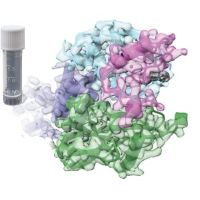Specification
| Description | Recombinant protein from the full-length sequence of Homo sapiens eukaryotic translation initiation factor 4A3 (EIF4A3) (NM_014740). |
| Organism | Homo sapiens (Human) |
| Expression Host | Human Cells |
| Tag Info | His or DYKDDDDK. Please contact us if you need further information or require specific designed tag. |
| Purity | Greater than 90% by SDS-PAGE gel |
| Uniprot ID | P38919 |
| Entry Name | IF4A3_HUMAN |
| Gene Names | EIF4A3 DDX48 KIAA0111 |
| Alternative Gene Names | DDX48 KIAA0111 |
| Alternative Protein Names | Eukaryotic initiation factor 4A-III (eIF-4A-III) (eIF4A-III) (EC 3.6.4.13) (ATP-dependent RNA helicase DDX48) (ATP-dependent RNA helicase eIF4A-3) (DEAD box protein 48) (Eukaryotic initiation factor 4A-like NUK-34) (Eukaryotic translation initiation factor 4A isoform 3) (Nuclear matrix protein 265) (NMP 265) (hNMP 265) [Cleaved into: Eukaryotic initiation factor 4A-III, N-terminally processed] |
| Application | Antigens, Western, ELISA and other in vitro binding or in vivo functional assays, and protein-protein interaction studies; For research & development use only! |
| Buffer | Purified protein formulated in a sterile solution of PBS buffer, pH7.2, without any preservatives |
| Endotoxin | Endotoxin level is < 0.1 ng/µg of protein (<1EU /µg) |
| Length | 411 |
| Molecular Weight(Da) | 46871 |
| Protein Sequence | (The sequence of expressed protein may have some variation from the sequence shown below. Please contact us for the exact sequence.) MATTATMATSGSARKRLLKEEDMTKVEFETSEEVDVTPTFDTMGLREDLLRGIYAYGFEKPSAIQQRAIKQIIKGRDVIAQSQSGTGKTATFSISVLQCLDIQVRETQALILAPTRELAVQIQKGLLALGDYMNVQCHACIGGTNVGEDIRKLDYGQHVVAGTPGRVFDMIRRRSLRTRAIKMLVLDEADEMLNKGFKEQIYDVYRYLPPATQVVLISATLPHEILEMTNKFMTDPIRILVKRDELTLEGIKQFFVAVEREEWKFDTLCDLYDTLTITQAVIFCNTKRKVDWLTEKMREANFTVSSMHGDMPQKERESIMKEFRSGASRVLISTDVWARGLDVPQVSLIINYDLPNNRELYIHRIGRSGRYGRKGVAINFVKNDDIRILRDIEQYYSTQIDEMPMNVADLI |
Background
| Function | FUNCTION: ATP-dependent RNA helicase (PubMed:16170325). Involved in pre-mRNA splicing as component of the spliceosome (PubMed:11991638, PubMed:22961380, PubMed:28502770, PubMed:28076346, PubMed:29301961). Core component of the splicing-dependent multiprotein exon junction complex (EJC) deposited at splice junctions on mRNAs (PubMed:16209946, PubMed:16170325, PubMed:16314458, PubMed:16923391, PubMed:16931718, PubMed:19033377, PubMed:20479275). The EJC is a dynamic structure consisting of core proteins and several peripheral nuclear and cytoplasmic associated factors that join the complex only transiently either during EJC assembly or during subsequent mRNA metabolism. The EJC marks the position of the exon-exon junction in the mature mRNA for the gene expression machinery and the core components remain bound to spliced mRNAs throughout all stages of mRNA metabolism thereby influencing downstream processes including nuclear mRNA export, subcellular mRNA localization, translation efficiency and nonsense-mediated mRNA decay (NMD). Its RNA-dependent ATPase and RNA-helicase activities are induced by CASC3, but abolished in presence of the MAGOH-RBM8A heterodimer, thereby trapping the ATP-bound EJC core onto spliced mRNA in a stable conformation. The inhibition of ATPase activity by the MAGOH-RBM8A heterodimer increases the RNA-binding affinity of the EJC. Involved in translational enhancement of spliced mRNAs after formation of the 80S ribosome complex. Binds spliced mRNA in sequence-independent manner, 20-24 nucleotides upstream of mRNA exon-exon junctions. Shows higher affinity for single-stranded RNA in an ATP-bound core EJC complex than after the ATP is hydrolyzed. Involved in the splicing modulation of BCL2L1/Bcl-X (and probably other apoptotic genes); specifically inhibits formation of proapoptotic isoforms such as Bcl-X(S); the function is different from the established EJC assembly (PubMed:22203037). Involved in craniofacial development (PubMed:24360810). {ECO:0000269|PubMed:11991638, ECO:0000269|PubMed:15034551, ECO:0000269|PubMed:16170325, ECO:0000269|PubMed:16209946, ECO:0000269|PubMed:16314458, ECO:0000269|PubMed:16923391, ECO:0000269|PubMed:16931718, ECO:0000269|PubMed:17375189, ECO:0000269|PubMed:19033377, ECO:0000269|PubMed:19409878, ECO:0000269|PubMed:20479275, ECO:0000269|PubMed:22203037, ECO:0000269|PubMed:22961380, ECO:0000269|PubMed:24360810, ECO:0000269|PubMed:28076346, ECO:0000269|PubMed:28502770, ECO:0000269|PubMed:29301961}. |
| Pathway | |
| Protein Families | DEAD box helicase family, eIF4A subfamily |
| Tissue Specificity | Ubiquitously expressed. {ECO:0000269|PubMed:10623621}. |
QC Data
| Note | Please contact us for QC Data |
| Product Image (Reference Only) |  |

